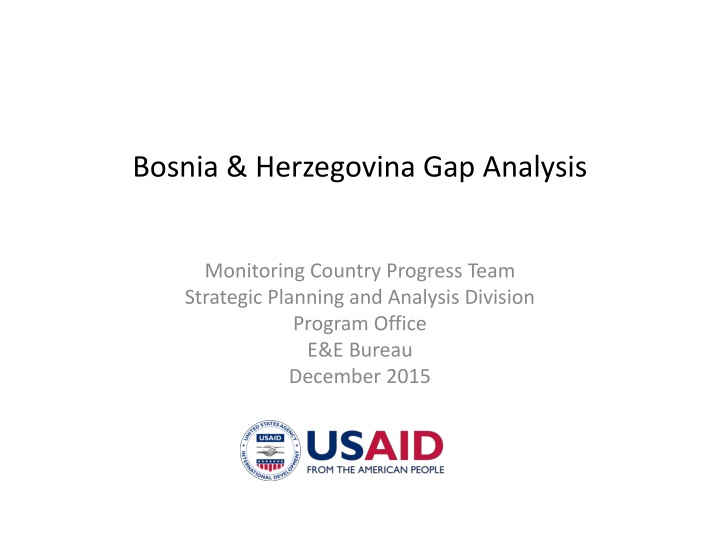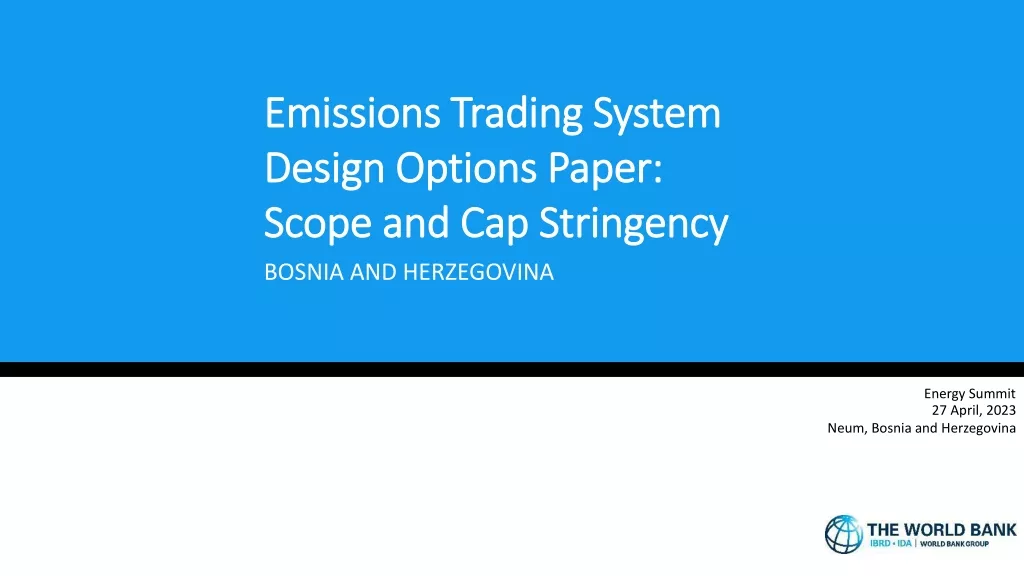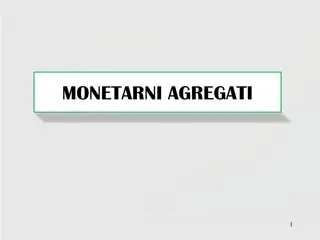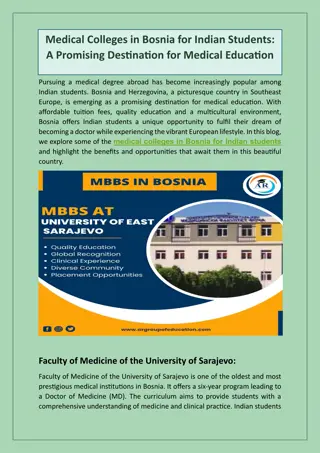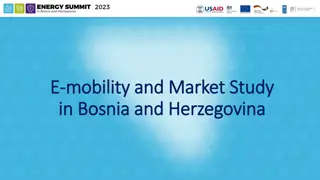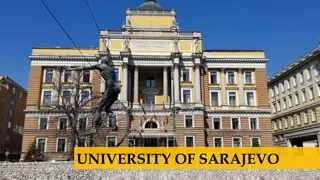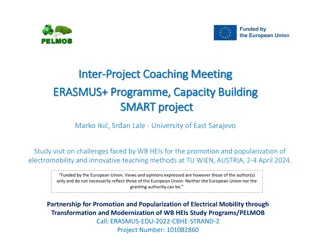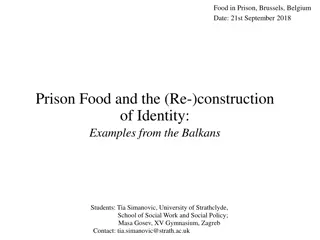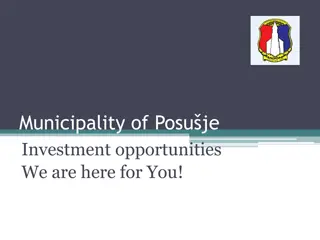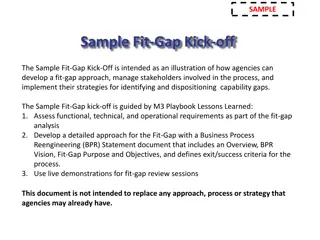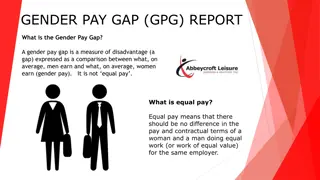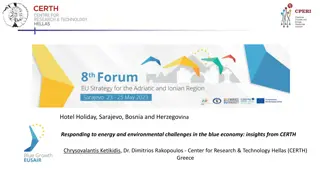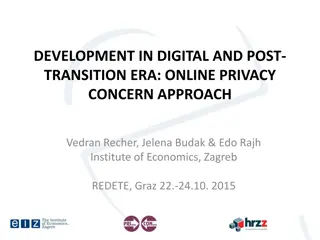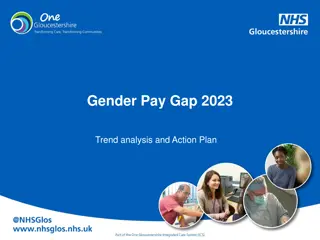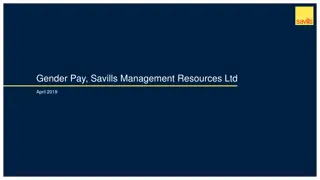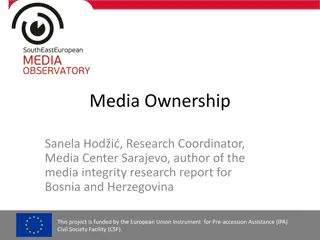Bosnia & Herzegovina Gap Analysis Monitoring
Monitoring the progress of country's reforms in democracy, governance, economic performance, and countering violent extremism. Analyzing economic and democratic reforms in Bosnia & Herzegovina from 1998 to 2014. Figures and data from reputable sources like Freedom House and EBRD are used for ratings.
Download Presentation

Please find below an Image/Link to download the presentation.
The content on the website is provided AS IS for your information and personal use only. It may not be sold, licensed, or shared on other websites without obtaining consent from the author.If you encounter any issues during the download, it is possible that the publisher has removed the file from their server.
You are allowed to download the files provided on this website for personal or commercial use, subject to the condition that they are used lawfully. All files are the property of their respective owners.
The content on the website is provided AS IS for your information and personal use only. It may not be sold, licensed, or shared on other websites without obtaining consent from the author.
E N D
Presentation Transcript
Bosnia & Herzegovina Gap Analysis Monitoring Country Progress Team Strategic Planning and Analysis Division Program Office E&E Bureau December 2015
Table of Contents: (1) Reform Overview (Figures 1-3) (2) Democracy and Governance (Figures 4-11) (3) Economic Reforms (Figures 12-17) (4) Economic Performance (Figures 18-32) (5) Human Capital (Figures 33-42) (6) Countering Violent Extremism (CVE) and Russian Pressure (CRP) (Figures 43-49) * See methodology annex for elaboration on the primary indices used in the MCP empirical system.
Figure 1 Economic and Democratic Reforms in Eastern Europe and Eurasia in 2014 5 Romania, Bulgaria, Croatia Threshold, 2006 Poland Estonia Czech Rep. 4 Slovak Rep. Latvia Lithuania Croatia Hungary Romania Bulgaria Slovenia Macedonia Georgia Economic Reforms Albania Montenegro Russia Armenia Ukraine 3 Moldova Kazakhstan Kyrgyz Rep. Serbia Bosnia & Herzegovina Azerbaijan Kosovo Tajikistan E&E Graduates The Balkans Belarus E&E Eurasia 2 Uzbekistan CARs Turkmenistan 1 1 2 3 4 5 Democratic Reforms Ratings are based on a 1 to 5 scale, with 5 most advanced. Freedom House, Nations in Transit (June 2015) and the European Bank for Reconstruction and Development (EBRD), Transition Report (November 2014).
Figure 2 Economic and Democratic Reforms in Eastern Europe & Eurasia 1998 5 2014 5 POL EST CZE 4 SLK LAT LIT CRO 4 HUN HUN SLV BUL CZE POL ROM Economic Reforms MAC EST Economic Reforms SLK GEO SLV RUS ARM ALB MNT LAT UKR MOL 3 CRO SER ROM KAZ KYR 3 B-H GEO LIT KYR KAZ KOS ARM AZE BUL MOL TAJ ALB RUS MAC AZE UKR S-M BEL UZB 2 2 B-H UZB TAJ TRK TRK Belarus Kosovo 1 1 1 2 3 4 5 1 2 3 4 5 Democratic Reforms Democratic Reforms Ratings are based on a 1 to 5 scale, with 5 representing most advanced. Freedom House, Nations in Transit (June 2015); and EBRD, Transition Report (November 2014).
Figure 3 Economic and Democratic Reforms in Bosnia & Herzegovina 5 4 1 to 5 Scale, with 5 the most advanced 3 Economic Reforms Democratic Reforms 2 1 1998 1999 2000 2001 2002 2003 2004 2005 2006 2007 2008 2009 2010 2011 2012 2013 2014 Economic reform data are drawn from the EBRD, Transition Report and democratic reform data from Freedom House, Nations in Transit.
Figure 4 Changes in Democratic Reforms in 2014 in Europe & Eurasia 0.15 Ukraine 0.10 Czech Republic Georgia Albania 0.05 1 to 5 Score Change from 2013 to 2014 Turkmenistan Kazakhstan Uzbekistan Lithuania Moldova Romania Armenia Slovenia Belarus Estonia Kosovo Croatia Latvia 0.00 E&E Euraisa Balkans CARs E&E Graduates Bosnia & Herzegovina Slovak Rep. Poland Montenegro Bulgaria Serbia Kyrgyz Republic -0.05 Macedonia Azerbaijan Tajikistan -0.10 Russia -0.15 Hungary -0.20 Data drawn from Freedom House, Nations in Transit series (June 2015, online). The E&E Graduates (n=11) consist of Estonia, Hungary, Latvia, Lithuania, Poland, Slovakia, Slovenia, Czech Republic, Romania, Bulgaria, and Croatia. The Balkans (n=6): Albania, Bosnia & Herzegovina, Macedonia, Kosovo, Serbia, and Montenegro. E&E Eurasia (n=7): Armenia, Azerbaijan, Belarus, Georgia, Moldova, Russia, and Ukraine. The Central Asian Republics or the CARs (n=5): Kazakhstan, Kyrgyzstan, Tajikistan, Turkmenistan, and Uzbekistan.
Figure 5 Democratic Reforms in Eastern Europe and Eurasia 5 E&E Graduates 4 1 to5 Scale, with 5 most advanced 3 Balkans Bosnia & Herzegovina 2 E&E Eurasia Central Asian Republics 1 1986 1987 1988 1989 1990 1991 1992 1993 1994 1995 1996 1997 1998 1999 2000 2001 2002 2003 2004 2005 2006 2007 2008 2009 2010 2011 2012 2013 2014 Data drawn from Freedom House, Nations in Transit series and Freedom in the World series. The E&E Graduates (n=11) consist of Estonia, Hungary, Latvia, Lithuania, Poland, Slovakia, Slovenia, Czech Republic, Romania, Bulgaria, and Croatia. The Balkans (n=6): Albania, Bosnia & Herzegovina, Macedonia, Kosovo, Serbia, and Montenegro. E&E Eurasia (n=7): Armenia, Azerbaijan, Belarus, Georgia, Moldova, Russia, and Ukraine. The Central Asian Republics or the CARs (n=5): Kazakhstan, Kyrgyzstan, Tajikistan, Turkmenistan, and Uzbekistan.
Figure 6 Bosnia & Herzegovina s Democratic Reform Profile in 2014 Electoral Process, 3.5 5 4 Anti-Corruption, 2.5 Civil Society, 3.3 3 2 1 Independent Media, 2.5 Rule of Law, 2.7 National Governance, 1.8 Local Governance, 2.5 USAID/E&E Country Graduates Romania, Bulgaria, Croatia in 2006 Drawn from Freedom House, Nations in Transit. Country Graduates (n=11): Bulgaria, Croatia, Czech Republic, Estonia, Hungary, Latvia, Lithuania, Poland, Romania, Slovakia, and Slovenia.
Figure 7 Democratic Reforms in Bosnia & Herzegovina, 1997-2014 5 4 1 to 5 Score, with 5 the most advanced Electoral Processes Civil Society 3 Rule of Law Anti-Corruption Independent Media Governance 2 1 1997 1998 1999-2000 2001 2002 2003 2004 2005 2006 2007 2008 2009 2010 2011 2012 2013 2014 Data drawn from Freedom House, Nations in Transit series.
Figure 8 National & Local Governance in Bosnia & Herzegovina, 1997-2014 5 4 1 to 5 Score, with 5 the most advanced 3 Local Governance Governance 2 National Governance 1 1997 1998 1999-2000 2001 2002 2003 2004 2005 2006 2007 2008 2009 2010 2011 2012 2013 2014 Data drawn from Freedom House, Nations in Transit series.
Figure 9 Government Effectiveness in the Balkans, 1996-2014 5 4 1 to 5 Score, with 5 the most advanced Montenegro 3 Macedonia Albania Kosovo Bosnia & Herz. 2 1 1996 1997 1998 1999 2000 2001 2002 2003 2004 2005 2006 2007 2008 2009 2010 2011 2012 2013 2014 World Bank, World Governance Indicators (2015).
Figure 10 Control of Corruption in the Balkans, 1996-2014 5 4 1 to 5 Score, with 5 the most advanced 3 Macedonia Bosnia & Herz. 2 Albania 1 1996 1997 1998 1999 2000 2001 2002 2003 2004 2005 2006 2007 2008 2009 2010 2011 2012 2013 2014 World Bank, World Governance Indicators (2015).
Figure 11 Perceptions of Corruption in 2014 100 90 80 70 Corruption Perceptions Index ( 0 - 100) 60 50 40 30 20 10 0 Romania Latvia Serbia Bulgaria Belarus Lithuania Moldova Macedonia Slovakia Albania Poland Bosnia & Herz Hungary Turkmenistan Armenia Montenegro Czech Republic Uzbekistan Tajikistan Ukraine Russia Kazakhstan Georgia Estonia Slovenia Croatia Kyrgyzstan Kosovo Azerbaijan Transparency International, 2014Corruption Perceptions Index. A score of 100 represents the least corruption possible, while a score of 0 represents the most corruption possible.
Figure 12 Economic Reforms in Eastern Europe and Eurasia 5 4 E&E Graduates 1 to 5 Scale, with 5 the most advanced Balkans 3 E&E Eurasia Bosnia & Herzegovina Central Asian Republics 2 1 1989 1990 1991 1992 1993 1994 1995 1996 1997 1998 1999 2000 2001 2002 2003 2004 2005 2006 2007 2008 2009 2010 2011 2012 2013 2014 USAID MCP system. Drawn from the EBRD Transition Report series. The E&E Graduates (n=11) consist of Estonia, Hungary, Latvia, Lithuania, Poland, Slovakia, Slovenia, Czech Republic, Romania, Bulgaria, and Croatia. The Balkans (n=6): Albania, Bosnia & Herzegovina, Macedonia, Kosovo, Serbia, and Montenegro. E&E Eurasia (n=7): Armenia, Azerbaijan, Belarus, Georgia, Moldova, Russia, and Ukraine. The Central Asian Republics or the CARs (n=5): Kazakhstan, Kyrgyzstan, Tajikistan, Turkmenistan, and Uzbekistan.
Figure 13 Bosnia & Herzegovina s Economic Reform Profile in 2014 Small Scale Privatization, 3.0 5 Infrastructure Reforms, 2.6 Trade and Foreign Exchange, 4.0 4 3 Non Bank Fin. Reform, 2.1 2 Price Liberalization, 4.0 1 Large Scale Privatization, 3.0 Banking Reform, 2.7 Enterprise Restructuring, 2.0 Competition Policy, 2.3 USAID/E&E Country Graduates Romania, Bulgaria, Croatia in 2006 Drawn from EBRD, Transition Report. Country Graduates (n=11): Bulgaria, Croatia, Czech Republic, Estonia, Hungary, Latvia, Lithuania, Poland, Romania, Slovakia, and Slovenia.
Figure 14 Reform Progress in Privatization in E&E in 2014 5 Balkans E&E Eurasia CARs 4 E&E Graduates 3 2 1 Drawn from EBRD, Transition Report (November 2014).
Figure 15 World Bank, Doing Business 2016 (October 2015). The Distance-to-Frontier score represents the gap between the economy s performance and measures of best practices across the World Bank s 10 components of doing business. On the Distance-to-Frontier 0-100 score, 100 represents the frontier, the optimal outcome.
Figure 16 Highest & Lowest Business Environment Component Rankings in Albania, Bosnia & Herzegovina, & Kosovo (2015) 200 189th 175th 180 171st 163rd 162nd 160 136th 140 120 Global Rank 100 80 60 38th 37th 40 32nd 28th 28th 20 8th 0 Albania: Dealing w/ Construction Permits Bosnia-H: Starting a Business Bosnia-H: Dealing w/ Construction Permits Kosovo: Resolving Insolvency Albania: Getting Electricity Kosovo: Dealing w/ Construction Permits Bosnia-H: Resolving Insolvency Albania: Trading Across Borders Kosovo: Registering Property Bosnia-H: Trading Across Borders Kosovo: Getting Credit Albania: Protecting Minority Investors World Bank, Doing Business 2016 (October 2015).
Figure 17 Getting Electricity in the World (2015) 100 90 80 (the higher the score, the better the environment) 70 Distance to Frontier Scores 60 50 40 30 20 10 0 Gambia, Dominic Macedo Hong Banglad Marshall Russian Puerto Antigua Guatem Korea, Switzerla Kazakhstan Lithuania Niger Burundi Romania Belarus Argentina Latvia Tonga Cambodia Suriname Malaysia Guyana Togo Poland Dominica Austria Chad Zimbabwe Hungary Canada Belize Colombia Portugal Ukraine Ghana Bolivia Sri Lanka Mauritius Tajikistan Bahrain Belgium Kiribati Maldives Ecuador Ethiopia Cameroon Pakistan Serbia Tajikistan Bosnia -H World Bank, Doing Business 2015 (October 2014). Getting Electricity is one of 10 components that comprise the World Bank s Ease of Doing Business rankings. The Distance-to-Frontier score represents the gap between the economy s performance on getting electricity and measures of best practices globally. On the Distance-to-Frontier 0-100 score, 100 represents the frontier, the optimal outcome.
Figure 18 Real GDP relative to 1989 GDP in the Balkans 240 220 200 Albania 180 160 140 1989 GDP = 100 120 Macedonia 100 Montenegro Serbia 80 Bosnia & Herzegovina 60 40 20 0 1989 1990 1991 1992 1993 1994 1995 1996 1997 1998 1999 2000 2001 2002 2003 2004 2005 2006 2007 2008 2009 2010 2011 2012 2013 2014 2015 Data taken from EBRD, Transition Reports, and IMF World Economic Outlook (April 2015).
Figure 19 Real GDP relative to 2000 GDP in the Balkans 200 Albania 180 Kosovo 160 Montenegro Serbia Macedonia Bosnia & Herzegovina 2000 GDP = 100 140 120 100 80 60 2000 2001 2002 2003 2004 2005 2006 2007 2008 2009 2010 2011 2012 2013 2014 2015 IMF World Economic Outlook (April 2015).
Figure 20 Economic Growth and Contraction in Bosnia & Herzegovina vs. the Balkans and the Euro Area 10 8 6 Real GDP (Annual % Change) 4 Balkans 2 Bosnia & Herz. Euro Area 0 -2 -4 -6 IMF, World Economic Outlook (October 2015).
Figure 21 Bosnia & Herzegovina's Integration in the Global Economy 70 External Debt 60 50 40 Exports of Goods & Services 30 % of GDP 20 10 Foreign Direct Investment 0 Current Account Balance -10 -20 -30 2000 2001 2002 2003 2004 2005 2006 2007 2008 2009 2010 2011 2012 2013 2014 EBRD, 2014Transition Report (November 2014); World Bank, World Development Indicators (2015), and IMF, World Economic Outlook (April 2015).
Figure 22 Outward Orientation of the Balkans (Exports as % of GDP) 100 90 80 70 60 Macedonia % of GDP 50 40 Albania 30 Bosnia & Herzegovina 20 Kosovo 10 0 2000 2001 2002 2003 2004 2005 2006 2007 2008 2009 2010 2011 2012 2013 World Bank, World Development Indicators (2015) and IMF, Kosovo Country Report (July 2015).
Figure 23 Top Export Destinations of the Balkan Countries Albania, 2013 Bosnia & Herzegovina, 2013 Austria, 12.0% Other, 9.2% Slovenia, 17.3% Other, 24.8% Italy, 43.5% Serbia Croatia, 15.6% India, 6.1% Germany, 31.1% Italy, 16.2% Italy, 14.8% Kosovo, 7.5% China, 9.7% Germany, 11.9% Spain, 8.4% Other, 50.9% Bosnia and Herzegovina, 8.1% Kosovo, 2012 est. Macedonia, 2014 est. Russia, 7.2% Romania, 5.7% Italy, 25.8% Other, 33.7% Other, 31.5% Germany, 41.3% Albania, 14.6% Greece, 4.6% Switzerland, 5.4% Kosovo, 4.7% Germany, 5.4% Macedonia, 9.6% Bulgaria, 6.6% China, 5.5% Italy, 6.1% Serbia, 5.2% CIA, World Factbook (2015).
Figure 24 Current Account Balance in the Balkans and Greece (% of GDP) 2 Greece 0 -2 -4 Kosovo -6 % of GDP -8 Bosnia & Herzegovina -10 -12 Albania -14 -16 -18 2005 2006 2007 2008 2009 2010 2011 2012 2013 2014 World Bank, World Development Indicators (2015) and IMF, Kosovo Country Report (July 2015).
Figure 25 Foreign Exchange Reserves in the Balkans and Greece (in Months of Imports) 10 9 8 Serbia 7 Bosnia & Herzegovina 6 Months of Imports 5 Albania Macedonia 4 Kosovo 3 2 Greece 1 0 2005 2006 2007 2008 2009 2010 2011 2012 2013 2014 World Bank, World Development Indicators (2015).
Figure 26 External Debt in the Balkans (% of GDP) 100 90 Serbia 80 Macedonia 70 Albania 60 Bosnia & Herzegovina % of GDP 50 40 30 Kosovo 20 10 0 2002 2003 2004 2005 2006 2007 2008 2009 2010 2011 2012 2013 2014 World Bank, World Development Indicators (2015) and IMF, Kosovo Country Report (July 2015).
Figure 27 Public Debt in the Balkans and Greece (% of GDP) 200 180 2008 160 2014 140 120 % of GDP 100 80 60 40 20 0 Greece Serbia Albania Bosnia & Herzegovina Macedonia Kosovo Economist Intelligence Unit, Greek Crisis, Impact on Neighbors (June 2015), IMF, various country reports, and Financial Times.
Figure 28 Fiscal Balances in the Balkans (% of GDP) 4 2 0 2005 2006 2007 2008 2009 2010 2011 2012 2013 2014 % of GDP Kosovo Bosnia & Herzegovina -2 Macedonia -4 Albania -6 Serbia -8 World Bank, World Development Indicators (2015), IMF, various country reports (2014-2015), and the EIU, Greek Crisis: Impact on Neighbors (June 2015).
Figure 29 Quality of Bank Assets in the Balkans and Greece (Nonperforming loans % total loans) 40 35 Greece 30 25 Albania % of Total Loans Serbia 20 Bosnia & Herzegovina 15 Macedonia 10 Kosovo 5 0 2005 2006 2007 2008 2009 2010 2011 2012 2013 2014 World Bank, World Development Indicators (2015) and the IMF, Kosovo Country Report (July 2015).
Figure 30 Capital Adequacy Ratio in the Balkans and Greece 25 Serbia 20 Kosovo Bosnia & Herzegovina Bank Capital to Risk-Weighted Assets Macedonia 15 Albania Greece 10 International (Basel Accords) Requirement 5 0 2005 2006 2007 2008 2009 2010 2011 2012 2013 2014 IMF, EIU, and Deloitte Consulting, Partners for Financial Stability.
Figure 31 Employment in Agriculture (% of Total Employment) 45 40 35 30 % of Total Employment 25 20 15 10 5 0 Albania Armenia Moldova Bosnia-H Serbia Macedonia Greece France U.S. World Bank, World Development Indicators (2015). Latest year available; 2012 in most cases.
Figure 32 Agricultural Value Added (% of GDP) 25 Albania Armenia 20 Moldova 15 % of GDP Macedonia 10 Serbia Georgia Bosnia & Herzegovina 5 Greece France U.S. 0 2005 2006 2007 2008 2009 2010 2011 2012 2013 2014 World Bank, World Development Indicators (2015).
Figure 33 Remittances in the Balkans (% of GDP) 25 20 Kosovo Remittances (% of GDP) 15 Bosnia & Herzegovina 10 Serbia Albania 5 Macedonia 0 2004 2005 2006 2007 2008 2009 2010 2011 2012 2013 World Bank, World Development Indicators (2015).
Figure 34 Sources of Remittances in Bosnia & Herzegovina, 2014 (% of total Remittances) Other, 20.1% Croatia, 27.9% Greece, 0.2% Slovenia, 7.2% U.S., 8.8% Serbia, 15.6% Austria, 9.6% Germany, 10.6% World Bank, Migration and Remittances Working Group (2015).
Figure 35 Remittances and Unemployment Rates in Central & Eastern Europe in 2013 20 Kosovo 16 Remittances (% of GDP) 12 Bosnia & Herzegovina Montenegro Serbia Albania 8 Macedonia Lithuania 4 Hungary Bulgaria Croatia Latvia Romania Estonia Slovakia Slovenia Czech Rep. Poland 0 0 5 10 15 20 25 30 35 40 Unemployment Rate (as % of Total Labor Force) Kovtun D. et.al., Boosting Job Growth in the Western Balkans, IMF Working Paper, January 2014; World Bank, World Development Indicators (2015, online); and IMF, World Economic Outlook (April 2015). Unemployment data for Armenia are IMF estimates. Unemployment data for Albania, Kosovo, and Montenegro are derived from EC Country Progress Reports (October 2014).
Figure 36 Unemployment Rates in the Balkans and Greece 60 50 40 Kosovo % of Labor Force Macedonia 30 Bosnia & Herzegovina Greece Serbia Montenegro 20 Albania 10 0 2000 2001 2002 2003 2004 2005 2006 2007 2008 2009 2010 2011 2012 2013 2014 IMF, World Economic Outlook (April 2015). Albania s 2013 and 2014 unemployment data are from the World Bank, Country Partnership Framework(April 2015). Bosnia s 2014 unemployment data are from the Bosnia & Herzegovina 2015 Labor Force Survey. Kosovo s 2013 and 2014 unemployment data is from the Kosovo Agency of Statistics, 2014 Labor Force Survey.
Figure 37 Unemployment Rates in the Balkans since the 1980s Former Yugoslav Republics 50 45 40 35 30 % 25 20 15 10 5 0 Kosovo Macedonia Bosnia and Herzegovina Montenegro Serbia Slovenia Croatia Albania 80's 90's 00's UNICEF, 2013 TransMonEE Database. No data are available for Kosovo and Montenegro for the 1990s.
Figure 38 Long-term Unemployment in Bosnia & Herzegovina and Elsewhere in Europe 30 25 20 % of Labor Force 15 10 5 0 Macedonia Bosnia-H Balkans Serbia Greece Latvia Fracne France Sweden Bosnia & Herzegovina, 2015 Labor Force Survey (2015) and Kovtun, et. al., Boosting Job Growth in the Western Balkans, IMF Working Paper (January 2014).
Figure 39 Youth Unemployment in the Balkans 100 90 80 Unemployed 15-24 Year Olds, as a % of Labor Force 70 Bosnia & Herzegovina 60 Macedonia 50 Serbia Montenegro 40 Croatia Albania 30 20 10 0 1996 1997 1998 1999 2000 2001 2002 2003 2004 2005 2006 2007 2008 2009 2010 2011 2012 UNICEF, 2014 TransMonEE Database. Ages 15-24 years.
Figure 40 Labor Force Participation Rate (employed and seeking employment as % of working age population) 90 80 70 60 % of Working Age Population 50 40 30 20 10 0 Bosnia-H Montenegro Balkans Serbia Macedonia Albania France Latvia Sweden Bosnia & Herzegovina, 2015 Labor Force Survey (2015) and Kovtun et al, Boosting Job Growth in the Western Balkans, IMF Working Paper, (January 2014).
Figure 41 Labor Force Participation Rate in Bosnia & Herzegovina, 2015 (Employed and Seeking Employment as % of Working Age Population) 70 FB-H Federacija Bosne i Hercegovine RS Republika Srpska DB Distrikt Br ko BiH 60 50 % of Working Age Population 40 30 20 10 0 DB (Females) DB (Males) FB-H (Females) FB-H (Males) RS (Females) RS (Males) Bosnia & Herzegovina, 2015 Labor Force Survey (2015).
Figure 42 Unemployment Rate in Bosnia & Herzegovina, 2015 40 FB-H Federacija Bosne i Hercegovine RS Republika Srpska DB Distrikt Br ko BiH 35 30 % of Working Age Population 25 20 15 10 5 0 DB (Females) DB (Males) FB-H (Females) FB-H (Males) RS (Females) RS (Males) Bosnia & Herzegovina, 2015 Labor Force Survey (2015).
Figure 43 Foreign Fighters in Europe and the U.S. in 2014 1600 1400 1200 Total # of Foreign Fighters 1000 800 600 400 200 0 Kosovar Center for Security Studies, Report Inquiring into the Causes and Consequences of Kosovo Citizens Involvement as Foreign Fighters in Syria and Iraq, (April 2015) and ICSR (The International Centre for the Study of Radicalization and Political Violence, January 2015).
Figure 44 Foreign Fighters per Million People in Europe and the U.S. in 2014 140 120 # of Foreign Fighters (per Million People) 100 80 60 40 20 0 Kosovar Center for Security Studies, Report Inquiring into the Causes and Consequences of Kosovo Citizens Involvement as Foreign Fighters in Syria and Iraq, (April 2015) and ICSR (The International Centre for the Study of Radicalization and Political Violence) (January 2015).
Figure 45 Economic Context for Countering Russian Pressure: Merchandise Exports to Russia from the Balkans 20% 18% 16% 14% % of Merchandise Exports 12% 10% 8% Serbia 6% 4% Montenegro 2% Macedonia Bosnia & Herz. Albania 0% 1993 1994 1995 1996 1997 1998 1999 2000 2001 2002 2003 2004 2005 2006 2007 2008 2009 2010 2011 2012 2013 IMF, Direction of Trade Statistics (2015).
Figure 46 Sources of Foreign Direct Investment in the Balkans in 2012: Top 5 and Others (% of Total FDI) Bosnia & Herzegovina Macedonia Other, 22.3% Netherlands, 20.9% Austria, 23.8% Other, 30.5% Greece, 0.1% Austria, 11.8% Germany, 5.5% Serbia, 17.1% Russia, 0.3% Serbia, 2.1% Greece, 11.6% Russia, 8.4% Croatia, 13.5% Turkey, 3.9% Slovenia, 9.3% Hungary, 9.2% Slovenia, 9.7% Serbia Albania Canada, 18.6% Other, 18.7% Austria, 17.4% Russia, 0.1% Netherlands, 8.2% Other, 34.2% Greece, 17.3% Netherlands, 17.0% Turkey, 9.3% Italy, 12.3% Austria, 15.5% Cyprus, 15.0% Russia, 4.7% Slovenia, 5.3% Greece, 6.4% UNCTAD, FDI/TNC database (2015)..
Figure 47 Percentage of Crude Oil Imports from Russia Albania Macedonia 100% Bosnia & Herzegovina Serbia 80% Percentage of Imports from Russia 60% Croatia 40% 20% 0% 2010 2011 2012 2013 2014 BP, Statistical Review of World Energy (June 2015).
Figure 48 Percentage of Gas Imports from Russia 90% Serbia 80% 70% Bosnia & Herzegovina Percentage of Imports from Russia 60% Macedonia 50% 40% 30% Albania 20% 10% 0% 2010 2011 2012 2013 2014 BP, Statistical Review of World Energy (June 2015).
